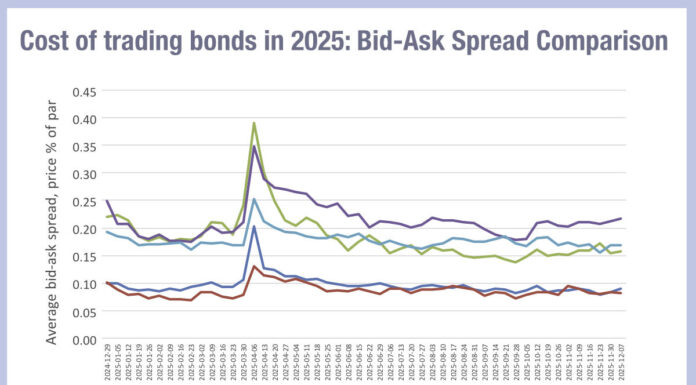Ted Douglas, Co-Head of Global Fixed Income, Capital Formation at IHS Markit spoke to The DESK about the dynamics of bond issuance for the buy side.
What capabilities can buy-side traders see today, and in the future, using your primary markets platform?
Today, we bring fantastic global coverage across APAC, European, and the US primary markets for both the buy side and sell side.
Our InvestorAccess solution brings together investors and banks, with the ability to participate in primary new issuance, integrated into an investor’s current workflow. InvestorAccess incorporates all the workflows relating to the distribution of deal terms and communication of orders and allocations, benefiting the buy side as well as all participants in the process.
Our primary markets platform is supported by IssueNet, a unique network of primary member banks linked by technology that synchronises deal and orderbook information between the syndicate desks. Since taking the lead on this joint operation from ICMA and over the years, IssueNet has become the market-accepted utility for the largest global sell-side banks.
How does that translate to delivering a more efficient primary market process?
In addition to the market-leading utility IssueNet, our InvestorAccess system has nearly 500 buy-side firms on the platform, and of the 200+ banks [using IssueNet to synchronise orders], 55 banks also publish new issuance deals through InvestorAccess.
The capabilities of the InvestorAccess platform are significant in improving the buy-side and sell-side efficiencies in new issues. InvestorAccess provides standardised offering protocols and reference data, which enhances the buy side’s ability to assimilate offering information more quickly. InvestorAccess incorporates all the work flows electronically: terms and conditions, indication of interest, order communications, and allocation release notifications. We provide clients with the ability to follow the entire process through a web portal or via our Deal Services API which can be consumed into an order management system (OMS), other execution venues, and integrated with other vendors, all of which we are beginning to roll out now.
It is the complete and total workflow solution, electronically sharing data in real-time across the markets that enables InvestorAccess to drive benefits of automation, reconciliation, reduced user errors, and speed of execution – collectively bringing tremendous efficiencies to the desk.
Last year saw record issuance volumes; what was stopping the wider adoption of technology to increase efficiency?
Any technology that is used for advancement or disruptive benefit generally doesn’t restrict, negate, stop or provide additional barriers to progress. It allows users to leapfrog roadblocks, creating a continuation and extension of progress.
Access to new issue information data, in real time, along with open, interoperable connectivity is key for buy-side traders using any system in the marketplace. Any prospective or future product/company that would create a closed network, thereby limiting participation in the critical capital raising process, would fail to demonstrate technology innovation, advancement in efficiency, or a healthy market disruption.
At IHS Markit, our products support the entire marketplace to participate in the capital formation process, irrespective of name, domicile, or market position and ranking. We enable the electronic transmission of deal information across the buy side and sell side, electronically, and in real-time, to enhance speed, reduce errors, increase transparency, and provide an auditable record for compliance and regulatory reporting requirements. We are currently integrating our services to other systems, which includes new entrants and existing vendors to ensure that whichever interface a buy-side trader is using, their process is connected to the sell side.
Vendors that are not genuinely ‘open and interoperable’ will not benefit the capital markets community and would further delay increased efficiencies for all participants. In addition, it will cause fragmentation of the primary market at which point the benefits of automation are reduced. If you had to have five phones to use five apps, you would use fewer apps. To access more apps, your phone needs to interoperate with them all.
If there are five portals with no connectivity, it will increase cost and risk, and reduce the efficiencies that can be realised through automation and that’s not good for the industry. A healthy, open marketplace does not include restrictive gating, or throttling of data. We have offered integration and if that is not accepted, the buy side may see a fragmentation of services across platforms that, due to a lack of connectivity, do not improve service. It is really that simple.
How do you evidence your potential as part of this?
In the European and APAC markets we have continuously grown the InvestorAccess community; quarter on quarter we have added more buy-side firms to the platform and we have seen consistent increases in client utilisation for both the sell side and buy side. In the EMEA region, we have been asked to publish and share more than 90% of all deals and in APAC we are already up to 80%. This is significant and demonstrates both the market’s confidence in, and acceptance of our complete primary capital market digital solutions. In these regions, the buy side has asked for increased market coverage electronically and the banks agreed and as a result have created a more open, transparent, and efficient marketplace. In fact, from an order flow perspective we are seeing a continuous growth year-on-year, and quarter-on-quarter growth to the order numbers. In 2020 we handled a five times greater number of orders over the InvestorAccess platform than in FY 2018. Similarly, in 2020 we also had 50% more deals running on our platform than in 2018. This further demonstrates the market’s expanding desire to view, indicate interest, price, enter orders, and receive allocation notification electronically for simple, easy to use functionality and efficiency.
We would like to point out that the potential for increased efficiencies remain.
Considering that our IssueNet platform was used to synchronise US$4.3 trillion in new issues last year, and that the US banks used IssueNet for more than 98% of new issuance deals but shared less than 10% of deal terms to the buy-side community, we see tremendous efficiency potential for US marketplace.
I think the US markets have been slower to change. Traditional ways of doing business have existed for some time and market participants are often reluctant to change. If we look back at equities markets from the early 2000s –when we had the proliferation of ECNs for equity trading – this innovation, while resisted by many, ultimately was more widely adopted and has improved the flow of data, created easier access to markets, and improved transparency. We have this technology today, and available globally for the primary fixed income markets.
What characterises your engagement with the sell side?
We have been partnering with the sell side for almost 20 years and they have been actively involved in the development of our fixed income network. We have enabled seamless integration across our IHS Markit products as well as client-hosted and vendor-borne products, so while we offer IssueBook to most banks on IssueNet, some clients prefer to have their own bookbuild software and we support this connectivity and integration. And we provide a permission-based decisioning process for how all information is disseminated from the sell side across to the buy side. We are directed by the banks to extend the service to the buy side, and we do this via our InvestorAccess platform. Since we are bank and investor agnostic, we promote sharing of deal information to all; however, the sell side and buy side remain in control of who they send information to and who they receive information from.
How else are you engaging with the market?
We have openly invited and offered integration across our primary new issuance products with vendors, new entrants, and the entire sell-side and buy-side marketplace.
We regularly host both buy-side and sell-side steering group meetings with client members. Most recently, we brought together more than 180 individuals, representing more than 75 banks and investor firms to explore and discuss their needs.
In addition to engaging with clients, we are always looking to expand the communities we serve. Last year we announced an expansion in APAC, whereby we have a joint venture with Hundsun Technologies Inc, a leading provider of financial software and network services in China that offers a suite of integrated asset management solutions to financial institutions and investors. Today, Hundsun currently counts 17 of the top 20 Chinese banks, public funds, futures companies, exchanges, and PE firms as clients. This represents a significant market opportunity to extend IHS Markit’s fixed income primary solutions into mainland China’s growing debt capital markets. In the near future, we will connect China to the global capital markets community, enabling sell-side and buy-side firms to engage bi-directionally for deal information, orders, and allocations.
We have already executed our first deal that has come out of mainland China. And we are currently building on the opportunity where we can extend more China deals into the APAC regions. This highlights the importance of integration, partnership and collaboration for the global marketplace and the buy-side community.
What will the SEC-approved, FINRA-run new-issue reference database offer?
The FINRA database provides us with another opportunity to support our customers via extending the primary new issue data out to the FINRA and out to the public, electronically, and expeditiously. We plan on incorporating this new-issue reference dataset into our products, enhancing the efficiencies we can provide our customers. This will allow deal terms, market interest and participation to be reported more transparently. We welcome this approach from FINRA as it will create more transparency, price discovery, and ‘connective tissue’ for the entire marketplace; this is highly consistent with our approach. From our standpoint it’s further opening the gates to sharing more data with the market and will serve to increase efficiency, liquidity, and a healthy market.
The SEC’s Office of Investor Advocate recently published a report that covered primary investment grade marketsoutlining some of the buy side’s frustrations with the current process, including a lack of standard reference data that makes ingestion of new prospectuses difficult. What’s your reaction to the report?
We’ve been providing a solution for several years now that solves for the problems identified in the report and the related Credit Roundtable best practices. We have global clients that utilise our buy-side solutions and do not share this frustration. However, as we have noted previously, the US markets have been slow to adopt to change. For example, our InvestorAccess provides standardised offering protocols and reference data, which enhances the buy side’s ability to assimilate offering information more quickly. We also empower the sell side to communicate deal reference data contained in a prospectus through an API integration with the buy side that enables quick ingestion of this data, depending on when the underwriter chooses to communicate this information the buy side. We’re eager to engage the SEC and The Credit Roundtable to make sure the concerns identified in the report are addressed, at least insofar as technology and the buy side’s needs.
How are you enhancing your services in the future?
As I commented previously, marketplace integration across our products, clients and vendors is a key focus for our buy-side clients. And, we must continue to remain open and interoperable across our products to create and deliver real value for our clients. Additionally, another area of focus is data related as we seek to increase and enhance the information in our InvestorAccess platform, via our Deal Monitor portal and through our Deal Service API. This increased data has the opportunity to enhance the decision-making process for our clients. And lastly, as FINRA is publishing new-issue corporate bond reference data, we will bring as much of this data to our portals for clients. We see a continuation of transparency increases coming, and we believe we are best positioned to share this data with our clients for their best execution needs.
How are operational pressures on buy-side trading desks likely to change this year?
We will likely see deal activity continue at heightened levels making global connectivity, efficiency, and speed to execution paramount. We currently have the technology in place to handle the increased demands and growing needs of the primary market. Whether needs arise from requirements under FINRA rules, clients’ desire to ensure best practices are maintained for transparency, or the SEC’s requirements for transparency and fair dealing, we are well positioned with technology, people, and professional capabilities to assist our clients.
www.ihsmarkit.com/fixed-income-issuance
©Markets Media Europe 2025













